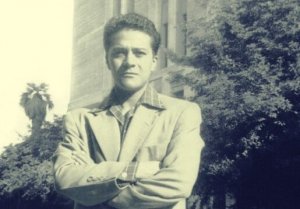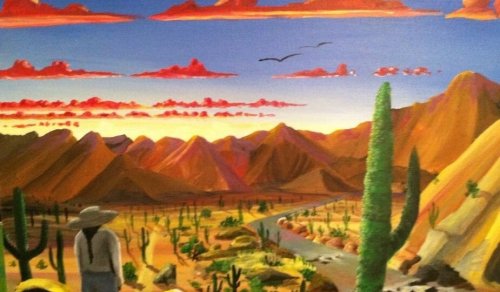Carlos Castaneda and His Interesting Journey

Carlos Castaneda is a difficult man to classify. For some, he was virtuous, ahead of his time, and endowed with impressive lucidity. For others, he’s merely a charlatan who speculated on ancient beliefs and became a millionaire by selling books that basically said nothing.
His real name was Carlos César Salvador Arana Castañeda and he was born in Cajamarca, Peru, on December 25, 1925. Despite the fact that he claimed to be Brazilian, there are copies of his birth certificate in the Inca country. He was the son of a jeweler and a housewife. He first studied in his hometown and then finished high school in Lima, Peru. Later, he studied at a fine arts school and he traveled to the United States when his mother died.
He took some creative writing and journalism courses in San Francisco. Then, he obtained a degree in Plastic Arts at UCLA and later a doctorate in anthropology. The details about his life are vague and imprecise since he erased his tracks when he began his spiritual transformation process.
What’s known is that he only kept his maternal last name and replaced the “ñ” with an “n” when he became a United States citizen. Since then, Carlos Castaneda is his official name.
Aspects of Carlos Castaneda’s life
At first, Carlos Castaneda didn’t have it easy in the United States. He sold hamburgers on the streets and worked as a taxi driver and hairdresser. Since 1960, before graduating as an anthropologist, he apparently met Juan Matus, a shaman from the Yaqui community in the Sonora desert in Mexico. They stayed in touch until 1973.

In 1960, Castaneda married Margaret Runyan, but a few months later he left her for another young woman named Mary Joan Barker. Carlos Castaneda admitted that he had a daughter named Marilyn Castañeda, whom he never recognized. Apparently, he did recognize other children even though they weren’t biological. He didn’t leave anything to his natural and biological daughter in his billionaire will.
Apparently, in his later years, Carlos Castaneda had several women as “acolytes”. According to Amy Wallace, daughter of the writer Irving Wallace, three of them were a part of his inner circle. All of them were his lovers and apparently agreed to a collective suicide upon his death.
A spiritual transformation
Carlos Castaneda became world-famous after the publication of his book The Teachings of Don Juan: A Yaqui Way of Knowledge. The first edition had a foreword by Octavio Paz. The text is a collection of Castaneda’s conversations with Don Juan Matus, with whom he supposedly began a learning process to become a Toltec nagual shaman.
According to Castaneda, Don Juan was the leader of the last group of sorcerers of a long dynasty. In his books, however, Castaneda combines Yaqui wisdom with Toltec traditions and even aspects of martial arts. His work isn’t verifiable from an anthropological point of view, and, therefore, lacks validity.
One of the aspects that most attracted the attention of his work was the description of altered states of consciousness, induced by hallucinogens. Apparently, Don Juan introduced him to the use of peyote, colloquially called “Mescalito” (the teaching spirit), among others. Castaneda didn’t present the field diaries of this experience, which is why many people think that Don Juan didn’t even exist. For them, the entire narrative is nothing more than literary fiction.

Carlos Castaneda has a story with many gaps
Carlos Castaneda wasn’t allowed to record or photograph. After making several publications along the same lines as the first, he announced that he would announce the “magic passes” around 1993. Thus, he created the Cleargreen Foundation to spread his new approach. He made several public appearances thereafter.
The work of Carlos Castaneda was controversial from the very beginning. He had followers around the world that were true fans of his work. John Lennon, Deepak Chopra, and Federico Fellini were among them. At the same time, his work was viewed with great suspicion in scientific circles. Even the FBI followed suit, suspecting that he was the leader of a dangerous cult.
There’s a great contradiction of dates in his work. Also, the data on Yaqui culture doesn’t coincide with the data collected by other scholars of the subject. Despite the strong doubts left by Castaneda’s work, he still has thousands of followers around the planet. He died of liver cancer in Los Angeles in 1998. However, the internal fire that he predicted would consume him from within outside, wrap him in light, and take him to another dimension didn’t happen.
Carlos Castaneda is a difficult man to classify. For some, he was virtuous, ahead of his time, and endowed with impressive lucidity. For others, he’s merely a charlatan who speculated on ancient beliefs and became a millionaire by selling books that basically said nothing.
His real name was Carlos César Salvador Arana Castañeda and he was born in Cajamarca, Peru, on December 25, 1925. Despite the fact that he claimed to be Brazilian, there are copies of his birth certificate in the Inca country. He was the son of a jeweler and a housewife. He first studied in his hometown and then finished high school in Lima, Peru. Later, he studied at a fine arts school and he traveled to the United States when his mother died.
He took some creative writing and journalism courses in San Francisco. Then, he obtained a degree in Plastic Arts at UCLA and later a doctorate in anthropology. The details about his life are vague and imprecise since he erased his tracks when he began his spiritual transformation process.
What’s known is that he only kept his maternal last name and replaced the “ñ” with an “n” when he became a United States citizen. Since then, Carlos Castaneda is his official name.
Aspects of Carlos Castaneda’s life
At first, Carlos Castaneda didn’t have it easy in the United States. He sold hamburgers on the streets and worked as a taxi driver and hairdresser. Since 1960, before graduating as an anthropologist, he apparently met Juan Matus, a shaman from the Yaqui community in the Sonora desert in Mexico. They stayed in touch until 1973.

In 1960, Castaneda married Margaret Runyan, but a few months later he left her for another young woman named Mary Joan Barker. Carlos Castaneda admitted that he had a daughter named Marilyn Castañeda, whom he never recognized. Apparently, he did recognize other children even though they weren’t biological. He didn’t leave anything to his natural and biological daughter in his billionaire will.
Apparently, in his later years, Carlos Castaneda had several women as “acolytes”. According to Amy Wallace, daughter of the writer Irving Wallace, three of them were a part of his inner circle. All of them were his lovers and apparently agreed to a collective suicide upon his death.
A spiritual transformation
Carlos Castaneda became world-famous after the publication of his book The Teachings of Don Juan: A Yaqui Way of Knowledge. The first edition had a foreword by Octavio Paz. The text is a collection of Castaneda’s conversations with Don Juan Matus, with whom he supposedly began a learning process to become a Toltec nagual shaman.
According to Castaneda, Don Juan was the leader of the last group of sorcerers of a long dynasty. In his books, however, Castaneda combines Yaqui wisdom with Toltec traditions and even aspects of martial arts. His work isn’t verifiable from an anthropological point of view, and, therefore, lacks validity.
One of the aspects that most attracted the attention of his work was the description of altered states of consciousness, induced by hallucinogens. Apparently, Don Juan introduced him to the use of peyote, colloquially called “Mescalito” (the teaching spirit), among others. Castaneda didn’t present the field diaries of this experience, which is why many people think that Don Juan didn’t even exist. For them, the entire narrative is nothing more than literary fiction.

Carlos Castaneda has a story with many gaps
Carlos Castaneda wasn’t allowed to record or photograph. After making several publications along the same lines as the first, he announced that he would announce the “magic passes” around 1993. Thus, he created the Cleargreen Foundation to spread his new approach. He made several public appearances thereafter.
The work of Carlos Castaneda was controversial from the very beginning. He had followers around the world that were true fans of his work. John Lennon, Deepak Chopra, and Federico Fellini were among them. At the same time, his work was viewed with great suspicion in scientific circles. Even the FBI followed suit, suspecting that he was the leader of a dangerous cult.
There’s a great contradiction of dates in his work. Also, the data on Yaqui culture doesn’t coincide with the data collected by other scholars of the subject. Despite the strong doubts left by Castaneda’s work, he still has thousands of followers around the planet. He died of liver cancer in Los Angeles in 1998. However, the internal fire that he predicted would consume him from within outside, wrap him in light, and take him to another dimension didn’t happen.
This text is provided for informational purposes only and does not replace consultation with a professional. If in doubt, consult your specialist.







